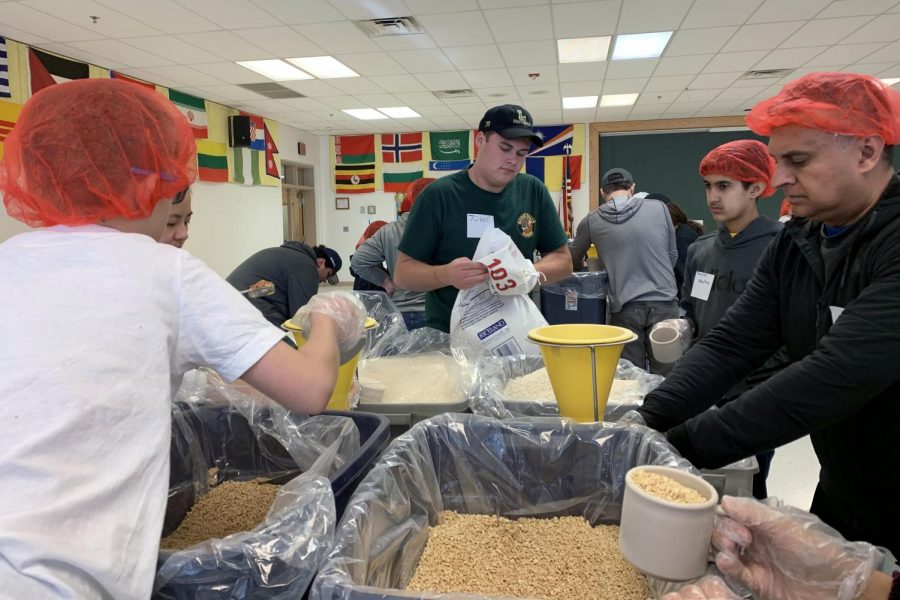The stories behind service
Saxons explain their personal tales and the benefits of community service
The only cord that can be worn during graduation without any effort put in grades, skills, or ability is the service learning cord. In order to earn this cord the only effort that is needed to put in this is to simply do 40 hours of service. Ten hours can be earned each year at Langley’s Saxon Service. Students only do 30 minutes of service time but get one hour worth of service.
Another cord that can be worn during graduation is the Civics cord but it does require knowledge and service hours. In order to earn the Civics seal, 50 hours of services needs to be done and with a B or higher in US/VA History in 11th grade and United States Government in 12th grade.
Some students have a good amount of service hours entered during their first year just like freshman Carlos Rojas. Rojos achieved his service hours through camp.
“I got my hours from creative summer which is my summer camp that I went to for 9 years ( which is why I got them there ) And now I am a counselor in training there,” Rojos said.
Rojos gets his service hours there every summer meaning that he would get alot of hours by the end of summer and the beginning of the school year.
“I got 100 hours done and I am pretty sure I put them all in,” Rojos said.
Even though Rojos has so many service hours done, he does not plan to get hours for Civic Seal right now.
“I plan to finish my hours and that’s all. If any opportunities come up I will see if I am interested,” Rojos said.
Proud that the amount of service hours he has completed has totaled the right amount for the service cord, Rojos still plans on continuing his efforts.
“What I did for my hours is super fun and I enjoy it a lot and I plan to do it for as long as I can,” Rojos said.
Rojos knows that there are countless things that can be done for community service.
“There is something out there for everyone and when lots of people pitch in to help the community, it makes the community better than before,” Rojos said. “Two minutes still makes a huge difference.”
Another student at Langley who is doing their service hours is freshman Natalie Hutchinson, who has five hours of service currently entered. Hutchinson thinks that Fairfax county requires its students to do service hours because it teaches students to be responsible.
“Kids here are especially privileged to be living in such a rich area, so they should know what it’s like to serve,” Hutchinson said.
Community service can benefit the community in many ways and everyone thinks about that in different ways.
“I think it’s important to give back to the community. helping your community, even out of obligation, is a great deed.” Hutchinson said.
Doing good deeds might help someone boost their confidence, Hutchinson feels proud for the amount of service she has given to her community. Hutchinson gets her hours from Iron out Cancer.
“It’s an organization that makes fun pillowcases for sick kids. I have ironed pillowcases at Saxon Service, but I mainly sew the pillows themselves because I’m a very good sewer,” Hutchinson said.
Linda Walsh has been running a program called “The Stanton Science Day”, she has been doing this for 15 years and it is held yearly. This is a program for the students of Stanton Elementary to learn about science. It is also a great opportunity for students at Langley to get their service hours.
Each year the subject taught at The Stanton Science Day changes and is a favorite event at Stanton elementary school. Walsh does this yearly so that she could reach a goal.
“The goal is to teach children that science is fun and we really can explore our world with limited equipment. We want to spark their scientific curiosity,” Walsh said.
Walsh holds these events because it is a fun, hands on environmental way to introduce scientific concepts. Walsh knows that the volunteers enjoy the day as much as the children receiving the knowledge of science. Another goal of Walsh is to help Stanton elementary school because it is located in a poor area.
“Our volunteers often have preconceived thoughts about how the children from a low resource community are going to act, think, etc. Our volunteers quickly learn that the Stanton students, while often behind in reading and math skills, are very curious and have excellent problem solving skills,” Walsh said.
While the volunteers learned about students of Stanton Elementary school, the students themselves also gleaned useful skills.
“The students learn new facts, investigative skills and ways to make sense of their world,” said Walsh.
Not only do the volunteers know about the student but also about what they can do.
“Volunteers get to watch the children explore and know they have helped expand the students perspective and planted the seed of curiosity – the root of all learning. They get to watch those light bulbs go on!” Walsh said.
Walsh thinks that community service helps prepare students for the future.
“We are building the leaders and volunteers of the future. It is a proven fact that children raised in a family or community that volunteers, will continue to volunteer as they mature into adults,” Walsh said.
The next Science Day is March 3–which will be a student holiday. For anyone interested in exploring the Chesapeake Bay Watershed on this day, contact Linda Walsh at [email protected].


